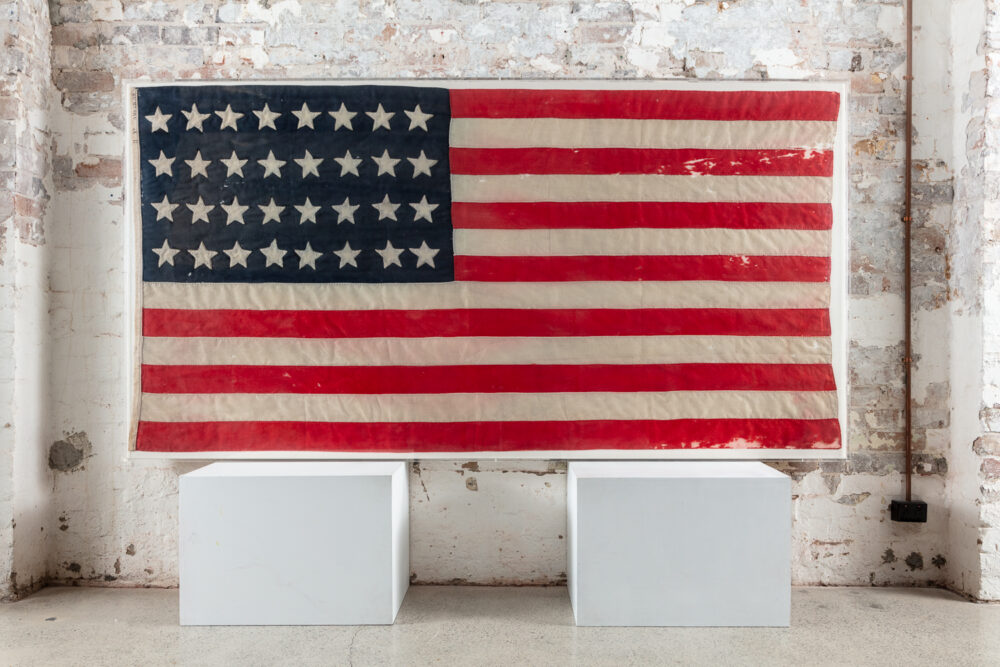

Tightly carved and engraved hardwood and natural pigment.
late 19th Century
This particularly strong Wunda Shield is an elongated ovoid form, the front decorated with fluted linear designs divided into three sections to form a zig-zag motif infilled alternately with red and black earth pigments. The reverse of the Wunda Shield is marked with fine fluted linear engraving and a raised loop handle.
Approx
77.5 cm length x 19cm wide
$7,000
Provenance
Reputedly collected in the Coolgardie region, Western Australia
Private collection, Queensland
Associated work
Wunda Shield, Western Australian, Metropolitan Museum of Art, New York, USA, accession number: 1979.206.1532
Adorned with bold zigzag patterns consisting of a series of longitudinal grooves accented with red and black ocher, Wunda Shields were once used across a large portion of the vast state of Western Australia. Like many forms of Aboriginal Shields, Wunda were used in fighting for protection against projectile weapons, such as spears and boomerangs. They were also carried by performers in ritual contexts, especially when re-enacting specific male ancestral stories.
The formal layout of the designs on Wunda Shields occurs in two basic patterns. In the first, known as pandal, which is seen on the present work, the lines in the upper and lower registers of the shield are arranged vertically along the axis of the shield, while those in the central register appear at an oblique angle. In the second, called pangkurda, the lines in the upper and lower registers run obliquely and those in the central section are horizontal. Zigzag designs in Western Australia appear to have been widely associated with rain and water. Broad patterns formed from nested zigzag motifs, such as those that appear on the Wunda Shields, are variously interpreted as representing ripple marks on the sand, floodwaters, or the ripples made by the wind on the surface of large bodies of water.
An Exceptional Wunda Shield, Western Australian, late 19th century
$7,000
In stock
Tightly carved and engraved hardwood and natural pigment.
late 19th Century
This particularly strong Wunda Shield is an elongated ovoid form, the front decorated with fluted linear designs divided into three sections to form a zig-zag motif infilled alternately with red and black earth pigments. The reverse of the Wunda Shield is marked with fine fluted linear engraving and a raised loop handle.
Approx
77.5 cm length x 19cm wide
$7,000
Provenance
Reputedly collected in the Coolgardie region, Western Australia
Private collection, Queensland
Associated work
Wunda Shield, Western Australian, Metropolitan Museum of Art, New York, USA, accession number: 1979.206.1532
Adorned with bold zigzag patterns consisting of a series of longitudinal grooves accented with red and black ocher, Wunda Shields were once used across a large portion of the vast state of Western Australia. Like many forms of Aboriginal Shields, Wunda were used in fighting for protection against projectile weapons, such as spears and boomerangs. They were also carried by performers in ritual contexts, especially when re-enacting specific male ancestral stories.
The formal layout of the designs on Wunda Shields occurs in two basic patterns. In the first, known as pandal, which is seen on the present work, the lines in the upper and lower registers of the shield are arranged vertically along the axis of the shield, while those in the central register appear at an oblique angle. In the second, called pangkurda, the lines in the upper and lower registers run obliquely and those in the central section are horizontal. Zigzag designs in Western Australia appear to have been widely associated with rain and water. Broad patterns formed from nested zigzag motifs, such as those that appear on the Wunda Shields, are variously interpreted as representing ripple marks on the sand, floodwaters, or the ripples made by the wind on the surface of large bodies of water.











